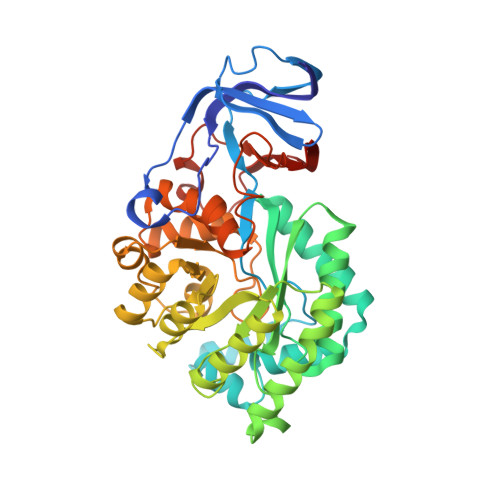A catalytic mechanism revealed by the crystal structures of the imidazolonepropionase from Bacillus subtilis
Yu, Y., Liang, Y.H., Brostromer, E., Quan, J.M., Panjikar, S., Dong, Y.H., Su, X.D.(2006) J Biological Chem 281: 36929-36936
- PubMed: 16990261
- DOI: https://doi.org/10.1074/jbc.M607703200
- Primary Citation of Related Structures:
2BB0, 2G3F - PubMed Abstract:
Imidazolonepropionase (EC 3.5.2.7) catalyzes the third step in the universal histidine degradation pathway, hydrolyzing the carbon-nitrogen bonds in 4-imidazolone-5-propionic acid to yield N-formimino-l-glutamic acid. Here we report the crystal structures of the Bacillus subtilis imidazolonepropionase and its complex at 2.0-A resolution with substrate analog imidazole-4-acetic acid sodium (I4AA). The structure of the native enzyme contains two domains, a TIM (triose-phosphate isomerase) barrel domain with two insertions and a small beta-sandwich domain. The TIM barrel domain is quite similar to the members of the alpha/beta barrel metallo-dependent hydrolase superfamily, especially to Escherichia coli cytosine deaminase. A metal ion was found in the central cavity of the TIM barrel and was tightly coordinated to residues His-80, His-82, His-249, Asp-324, and a water molecule. X-ray fluorescence scan analysis confirmed that the bound metal ion was a zinc ion. An acetate ion, 6 A away from the zinc ion, was also found in the potential active site. In the complex structure with I4AA, a substrate analog, I4AA replaced the acetate ion and contacted with Arg-89, Try-102, Tyr-152, His-185, and Glu-252, further defining and confirming the active site. The detailed structural studies allowed us to propose a zinc-activated nucleophilic attack mechanism for the hydrolysis reaction catalyzed by the enzyme.
- The National Laboratory of Protein Engineering and Plant Genetic Engineering, College of Life Sciences, Peking University, Beijing 100871, China.
Organizational Affiliation:


















